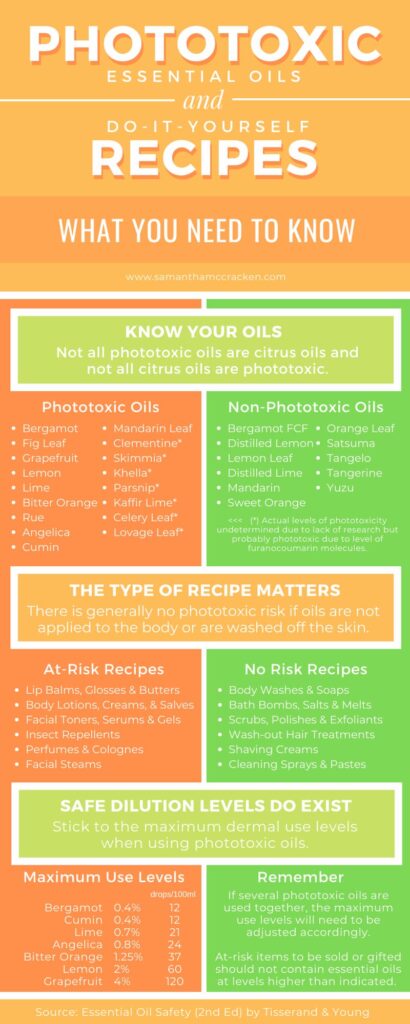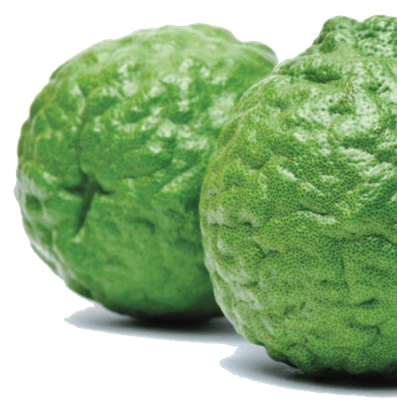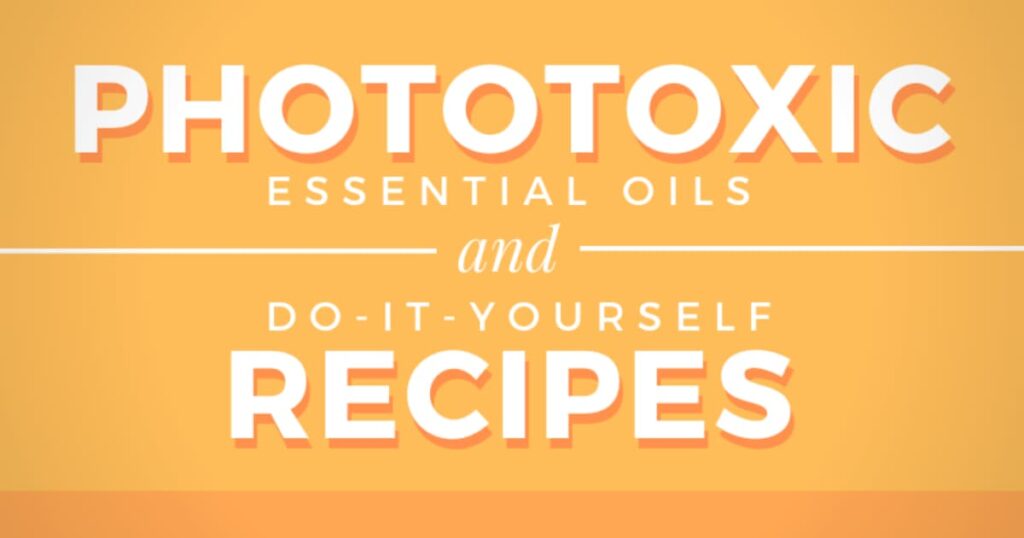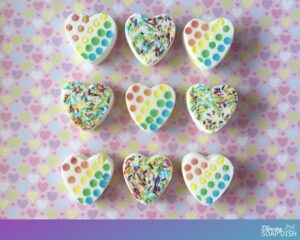When making your favourite essential oil DIY recipe, do you ever stop to think about whether your essential oils are safe to use in the way you have chosen?

How much is too much?
Could that cute little lip balm you made for a friend actually do them harm?
Today we’re talking about photosensitization and phototoxic essential oils and what you need to know about them to safely enjoy the essential oil recipes that you make yourself.
This post contains affiliate links. If you buy something through one of those links, I will receive a small commission at no extra cost to you. As an Amazon Associate I earn from qualifying purchases.
Thank you for supporting my site!
What is Photosensitization?
The following information is a summary from the text Essential Oil Safety (2nd Ed), 2014 by Robert Tisserand & Rodney Young
Photosensitization is a reaction to a substance applied to the skin that occurs only in the presence of ultraviolet (UV) light within the UVA range (approx 90% of UV radiation reaching the Earth’s surface).
Phototoxicity is a photosensitive reaction which involves irradiation (with UVA light) of areas of the skin where essential oils containing Furanocoumarin Molecules (FC’s) have been applied.
A reaction to phototoxic essential oils is recognized by the following symptoms:
- Inflamed and painful skin (like a sunburn)
- Possible blistering of the skin (in severe cases)
- Hyperpigmentation (like a very dark tan) that follows the reaction and can last for weeks, even months
These effects are delayed appearing 36-72 hours after UVA exposure.
Any essential oil containing Furanocoumarin molecules (FC’s) is potentially phototoxic. The amount of FC’s in an essential oil will determine the severity of the reaction, or if a reaction will occur at all (FC levels can be so low that the risk of a phototoxic reaction is negligible).
Unfortunately, reactions to phototoxic essential oils are common due to lack of awareness and knowledge about which oils are phototoxic and how to manage the risk of phototoxic reactions.
While there is no need to be overwhelmed by the many essential oil safety warnings out there, an understanding of the basics is essential if you make and gift your own essential oil recipes on a regular basis.
When creating my recipes for my blog, I refer to Tisserand & Young’s text ‘Essential Oil Safety‘ (2nd Ed), (2014). By using this reference I can make sure that the recipes I share can be enjoyed in a safe manner by all of my readers.
I highly recommend you get your own copy of this book. Then you can look up any essential oil to find out if there are any hazards or contraindications associated with its use.

It is also super useful for clarification of some of the contradictory essential oil advice and warnings found across the internet. You don’t have to take anyone’s word for it, you can simply look up the information yourself.
Before we begin…
First and foremost, refer to the safety instructions on your bottle of essential oil. Any reputable essential oil company should include safe use instructions for their phototoxic essential oils.
This could be anything from recommended dilution rates, warnings to stay out of the sun for a certain period following application, or even warnings against any topical use of a particular essential oil at all.
If the instructions on your bottle of essential oil differ from the information I have provided below, be sure to follow the instructions from your essential oil supplier. They have all the information about the FC’s present in their oils so they get the last say.
If you find their instructions confusing, then please contact them.
What you need to know about phototoxic essential oils!
Here are the key points I feel are important from my reading of Tisserand & Young’s Essential Oil Safety (2nd Ed) text.
I’ve listed them in this infographic, plus I discuss them further below.

Not all phototoxic essential oils are citrus and not all citrus oils are phototoxic.
Citrus oils are commonly known to cause photosensitive reactions with Bergamot being one of the biggest offenders due to its high levels of Begapten, a Furanocoumarin with a very strong degree of phototoxicity.
The most commonly known phototoxic essential oils are citrus oils and often, (for the sake of simplicity I imagine), a blanket warning is issued about photosensitivity for all citrus essential oils.
However it might surprise you to know that not all phototoxic essential oils are citrus and not all citrus oils are phototoxic.
For example, sweet orange oil (Citrus sinensis) is not phototoxic, hence its extensive use in many essential oil companies’ blends and body products.
On the other hand, Cumin Oil, which comes from a popular spice, is phototoxic with approximately the same degree of phototoxicity as Bergamot Oil.
Sometimes it’s not always black and white as Mandarin Oil is not phototoxic but Mandarin Leaf Oil is.
The following oils are phototoxic:
- Bergamot
- Fig Leaf
- Grapefruit
- Lemon
- Lime
- Bitter Orange
- Mandarin Leaf
- Rue
- Angelica
- Cumin
- Kaffir Lime*
- Celery Leaf*
- Lovage Leaf*
- Clementine*
- Skimmia*
- Khella*
- Parsnip*
* Actual levels of phototoxicity undetermined due to lack of research but probably phototoxic due to level of FC’s.
Different essential oil extraction methods lead to different levels of FC’s.
To make matters even more confusing, steam distilling Lemon and Lime Oil (as opposed to a cold-pressed extraction method) reduces the furanocoumarins to negligible amounts making them no longer phototoxic.
It’s also possible to chemically extract the Bergapten from Bergamot oil to negate its phototoxicity. This oil is supplied under the name Bergamot FCF (Furanocoumarin Free) and it not considered phototoxic.

The following oils are Non-Phototoxic:
- Bergamot FCF
- Distilled Lemon
- Lemon Leaf
- Distilled Lime
- Mandarin
- Sweet Orange
- Orange Leaf
- Satsuma
- Tangelo
- Tangerine
- Yuzu
The type of recipe you are making matters.
Not all essential oil DIY recipes carry the risk of photosensitization. How a product is applied to the skin also needs to be taken into account.
There is generally no phototoxic risk if the oils are used in a product that is either not applied to the body or is washed off the skin, such as shampoos, bath and shower products or soap. However, essential oils can adhere to the skin if used in a sauna or steam inhalation.
What does this mean? Well, phototoxic essential oils should definitely be avoided for certain essential oil DIY recipes, but can be used freely in others.
Recipes with Risk
- Lip Balms, Glosses & Butters
- Body Lotions, Creams & Butters
- Salves, Balms & Gels
- Toners & Serums
- Facial Oils
- Insect Repellents
- Lotion Bars
- Body Mists, Perfumes & Colognes
- Aftershave & Beard Oils
- Dry Shampoo and Body Powders
- Sensory Play not involving water
- Facial Steams
- Diffuser Jewellery where oils can easily come in contact with the skin
Recipes without Risk
- Shampoos, Conditioners and Hair Masks
- Body & Face Washes
- Toothpaste & Mouthwashes
- Bath Bombs, Bath Salts, Bath Teas & Bath Melts
- Foot Soaks
- Soap Bars & Liquid or Foaming Soaps
- Shaving Cream
- Scrubs, Polishes & Exfoliants
- Face Masks & Peels (left on for 5-10 minutes)
- Sensory Play involving water
- Room Sprays, Diffuser Ornaments & DIY Air Fresheners
- Cleaning Sprays and Pastes
- Dishwashing Liquids
- Laundry Detergents & Powders

Safe dilution levels do exist.
If you wish to add phototoxic essential oils to a recipe with a risk of a photosensitive reaction (see list above), you can manage the risk by adhering to the maximum use levels to avoid phototoxic reactions.
Maximum Use Levels
- Bergamot – 0.4% (12 drops per 100ml)
- Cumin – 0.4% (12 drops per 100ml)
- Lime – 0.7% (21 drops per 100ml)
- Angelica – 0.8% (24 drops per 100ml)
- Bitter Orange – 1.25% (37 drops per 100ml)
- Lemon – 2% (60 drops per 100ml)
- Grapefruit – 4% (120 drops per 100ml)
If several phototoxic oils are used together, the maximum use levels will need to be adjusted accordingly.
Items made from at-risk recipes to be sold or gifted should not contain essential oils higher than the maximum use levels.
Skin with applications at levels higher than those indicated should not be exposed to sunlight or UV lamps for 12-18 hours.
Maximum use levels have not been determined for all phototoxic essential oils. If you are unsure how much of an oil is safe to use, then you are better off leaving that essential oil out of your recipe.
Other ways to manage the risk:
- Cover up with clothing
- Wear sunscreen
- Use non-phototoxic citrus oils such as FCF Bergamot and distilled oils.
Create with Confidence!
So there you have it! Now you can get stuck in to a whole host of essential oil do-it-yourself recipes with confidence that you are not exposing yourself (or any of your homemade gift recipients) to the risk of a phototoxic reaction.
Enjoy!




